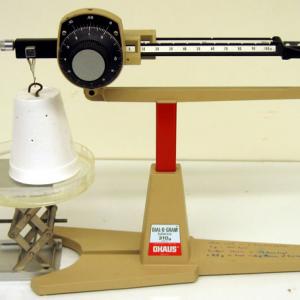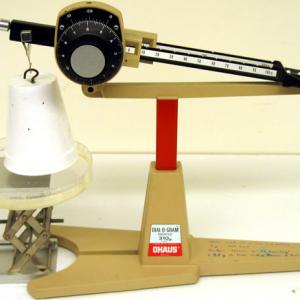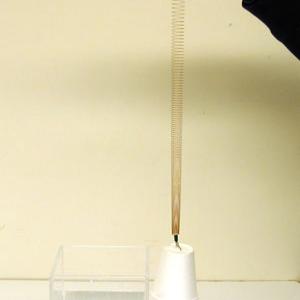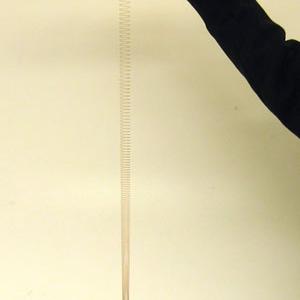College of Liberal Arts & Sciences
2A10.30 - Surface Tension Balance - Tensiometer
Place the cup with attached mass onto the scale in place of the pan. Zero the scale. Place the Petri dish that is 1/2 full of water onto the lab jack and position it under the cup. Raise the lab jack until the surface of the water touches the cup rim, and then adjust the jack up or down until the balance is re-zeroed. Now turn the dial of the scale up slowly. If done correctly, the cup should break free of the water surface when you reach 4.9 to 5 grams (4900 dynes).
An effective but non-quantitative way to demonstrate this is to just attach a spring to the cup. Measure how far the spring is stretched with just the cup hanging onto it, and then touch the rim of the cup to the surface of the water. You should now have to stretch the spring about twice the initial distance before it breaks free from the water surface.
- Alem-Mar B. Goncalves, Welica P. S. Freitas, Diego D. Reis, Cicero R. Cena, Diego C. B. Alves, Doroteia F. Bozano, "Surface Tension Measured with Arduino", TPT, Vol. 57, #9, Dec. 2019, p. 640-641.
- Julius H. Taylor, "Tensiometer", TPT, Vol. 10, # 8, Nov. 1972, p. 478.
- J. Pellicer, V. Garcia-Morales, L. Gaunter, M. J. Hernandez, and M. Doiz, "On the Experimental Value of the Water Surface Tension Used in Some Textbooks", AJP, Vol. 70, # 7, July 2002, p. 705.
- S. Y. Mak and K. Y. Wong, "The Measurement of Surface Tension by the Method of Direct Pull", AJP, Vol. 58, #8, Aug. 1990, p. 791.
- George M. Hopkins, "Molecular Actions", Experimental Science, p. 56.
- R. W. Pohl, Physical Principles of Mechanics and Acoustics, p. 171.
- Yves Pomeau and Emmanuel Villermaux, "Two Hundred Years of Capillarity Research", Physics Today, March 2006, p. 39.
Disclaimer: These demonstrations are provided only for illustrative use by persons affiliated with The University of Iowa and only under the direction of a trained instructor or physicist. The University of Iowa is not responsible for demonstrations performed by those using their own equipment or who choose to use this reference material for their own purpose. The demonstrations included here are within the public domain and can be found in materials contained in libraries, bookstores, and through electronic sources. Performing all or any portion of any of these demonstrations, with or without revisions not depicted here entails inherent risks. These risks include, without limitation, bodily injury (and possibly death), including risks to health that may be temporary or permanent and that may exacerbate a pre-existing medical condition; and property loss or damage. Anyone performing any part of these demonstrations, even with revisions, knowingly and voluntarily assumes all risks associated with them.



